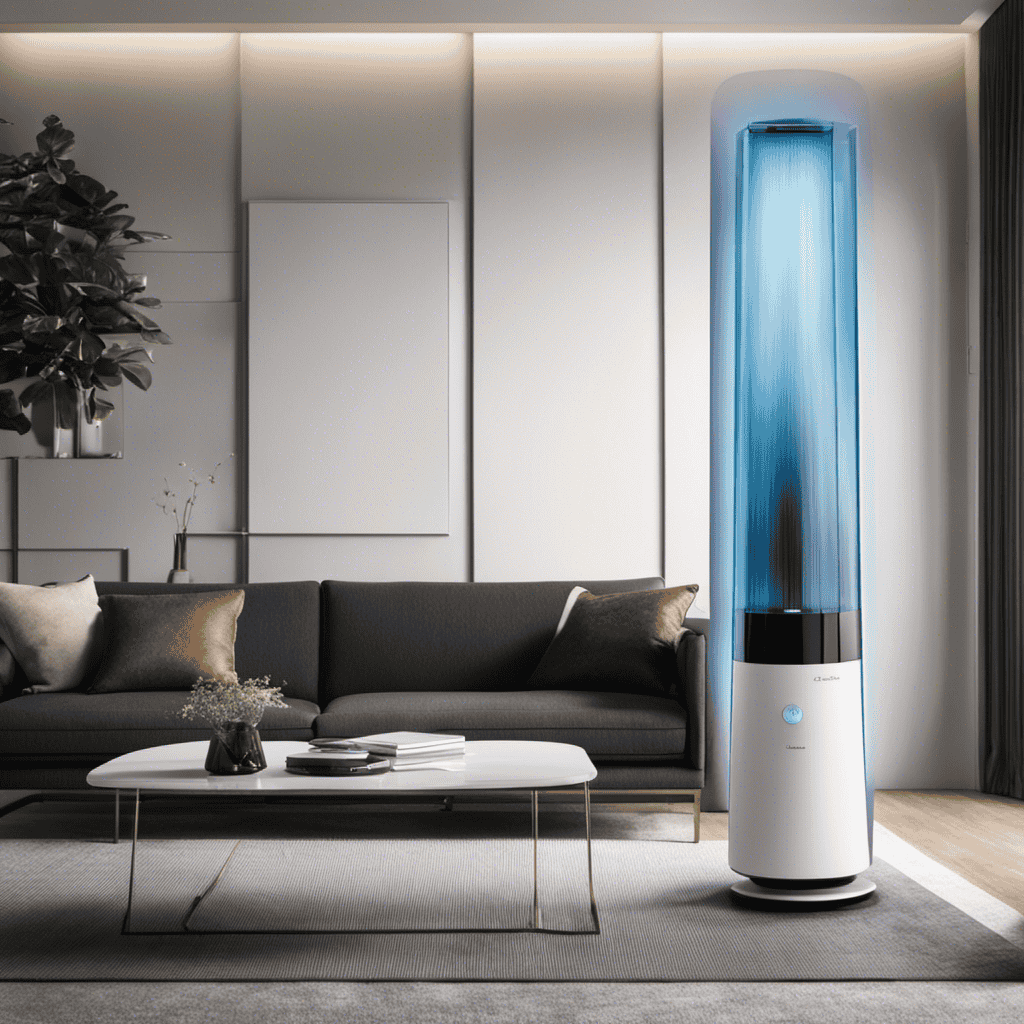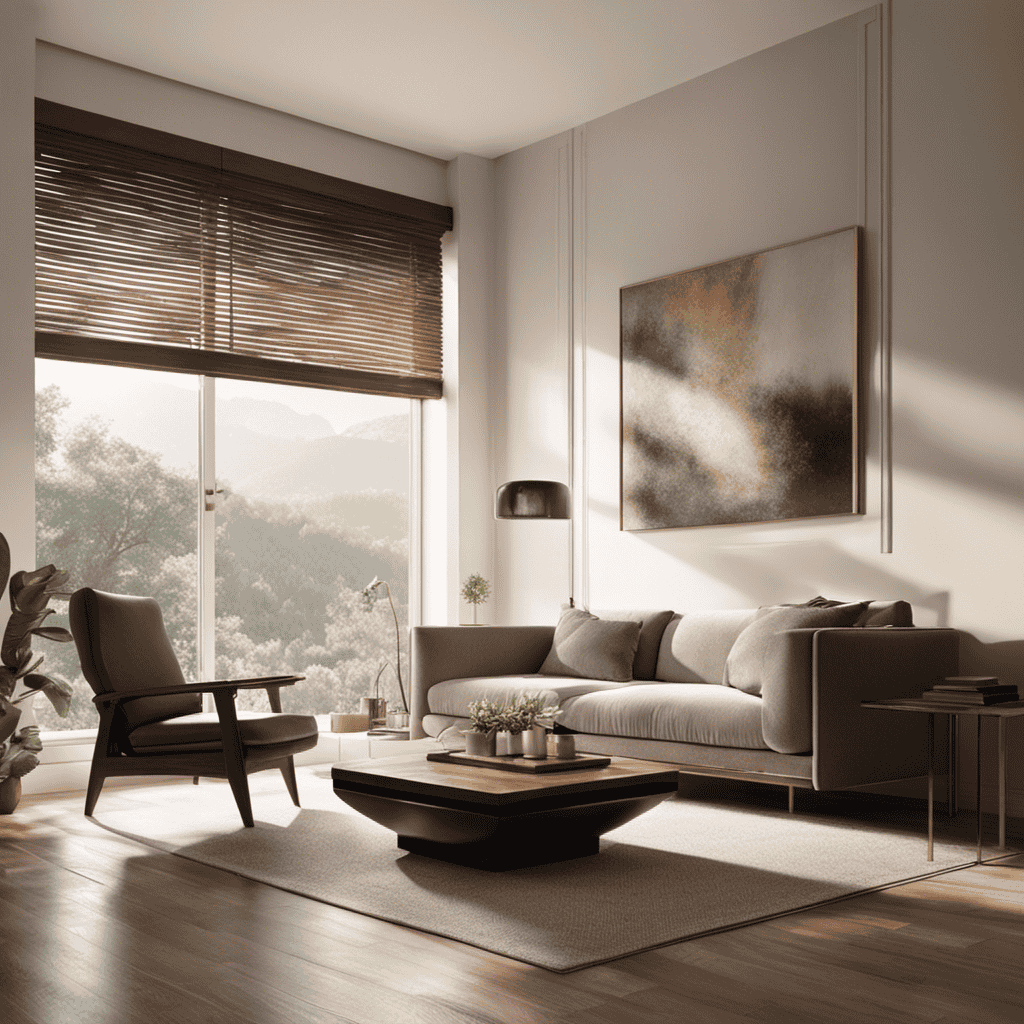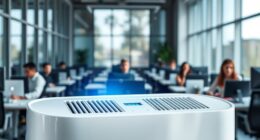I have valuable tips on where to position your Winix Air Purifier.
Did you know that indoor air can be up to five times more polluted than outdoor air? That’s why it’s crucial to position your air purifier correctly for maximum effectiveness.
In this article, I’ll guide you through the optimal placement for different areas in your home, including bedrooms, living rooms, kitchens, and home offices.
Let’s dive in and create a healthier and cleaner environment together.
Key Takeaways
- Choose a purifier suitable for the room size
- Identify sources of pollutants and place the purifier near those areas
- Position the purifier in an area with good air circulation
- Keep the purifier away from furniture or obstructions that may hinder air flow
Consider the Room Size
When considering the room size, you’ll want to make sure the Winix air purifier is placed in a space that is appropriate for its cleaning capacity. The size of the bedroom is an essential factor to consider when determining the right air purifier capacity.
It is crucial to match the purifier’s capacity with the room’s size to ensure optimal air cleaning. The ideal scenario is to have an air purifier that can clean the air in the entire bedroom effectively.
To determine the appropriate purifier capacity, you can use a simple calculation. Measure the length, width, and height of your bedroom and multiply these values together. The result will give you the approximate volume of your room.
Based on this volume, you can then choose an air purifier that has a corresponding recommended cleaning capacity.
Evaluate Air Circulation
Evaluating the air circulation is crucial when determining where to position the Winix air purifier. Proper air circulation is essential for the effective performance of the purifier in improving indoor air quality.
When evaluating air quality, factors such as the presence of pollutants, allergens, and odors should be considered. By placing the purifier in an area with good air circulation, it can efficiently capture and filter these airborne particles.
Good air circulation ensures that the purified air is distributed evenly throughout the room, providing clean and fresh air for everyone. Additionally, proper air circulation helps prevent the buildup of stagnant air, reducing the risk of mold and mildew growth.
To achieve optimal air circulation, it is important to avoid obstructions that may hinder the flow of air, such as furniture or curtains.
Avoid Obstructions
To achieve optimal air circulation, it’s important to avoid obstructions like furniture or curtains. These obstructions can hinder the flow of air and prevent the Winix air purifier from effectively cleaning the air in your space. Evaluating air quality is crucial when determining the placement of your air purifier. You should consider factors such as the size of the room, the number of occupants, and the presence of pollutants. Placing the air purifier near potential sources of pollutants, such as kitchens or smoking areas, can help improve air quality in those specific areas. Additionally, positioning the purifier in an area with good air circulation, away from corners or walls, can help distribute the purified air more efficiently. By evaluating air quality and avoiding obstructions, you can maximize the effectiveness of your Winix air purifier.
| Factors to Consider | Placement Tips |
|---|---|
| Room Size | Choose a purifier suitable for the room size to ensure efficient air cleaning. |
| Number of Occupants | If there are more people in the room, consider a larger capacity air purifier. |
| Presence of Pollutants | Identify the sources of pollutants and place the purifier near those areas. |
| Air Circulation | Position the air purifier in an area with good air circulation to distribute clean air effectively. |
| Avoid Obstructions | Keep the purifier away from furniture, curtains, or any obstructions that may hinder air flow. |
Optimal Placement for Allergies
If you have allergies, it’s important to consider optimal placement for your air purifier. Proper placement can greatly enhance the effectiveness of the purifier and improve the air quality in your home. Here are some key factors to consider when determining the best placement for your air purifier:
-
Room size considerations: Take into account the size of the room where you’ll be placing the air purifier. A larger room may require a more powerful purifier or multiple units to effectively clean the air.
-
Air circulation evaluation: Assess the airflow in the room. Place the purifier in an area where it can easily draw in and circulate the air. Avoid placing it in a corner or behind furniture that can obstruct the airflow.
-
Proximity to pollution sources: If there are specific sources of pollution in your home, such as a smoking area or a pet’s sleeping area, consider placing the purifier nearby to target those specific pollutants.
-
Accessibility for maintenance: Ensure that the purifier is easily accessible for filter changes and maintenance. Placing it in a convenient location will make it easier to keep the air purifier running efficiently.
Placement for Smoke and Odor Removal
Consider placing the purifier near areas where smoke and odor are most prevalent in order to effectively remove them from your home. When evaluating the effectiveness of a Winix air purifier in removing smoke and odor, proper placement is crucial.
Smoke particles and odorous molecules tend to linger in specific areas, such as near the kitchen or living room. By strategically placing the purifier in these locations, you can target and capture these pollutants more efficiently.
In terms of maintenance requirements, it is important to regularly clean and replace the filters in your Winix air purifier. The filters play a vital role in trapping and eliminating smoke particles and odorous molecules from the air. Over time, these filters can become clogged and less effective.
Ideal Location for Pet Owners
After discussing the ideal placement for removing smoke and odors, let’s now focus on the ideal location for pet owners like myself. When it comes to dealing with pet dander and allergens, it’s crucial to find the perfect spot for your Winix air purifier. Here are some important considerations:
-
Height: Place the air purifier at a height that allows it to effectively capture pet dander and hair that may float in the air.
-
Central Location: Position the purifier in a central area of the room to ensure maximum air circulation and filtration.
-
Avoid Pet’s Reach: Keep the air purifier out of your pet’s reach to prevent any accidental damage or disruption to its operation.
-
Near Pet’s Bedding: If your pet has a specific sleeping area, consider placing the air purifier nearby to capture any dander or allergens they may release while resting.
By following these guidelines, you can create an environment where you and your furry friend can breathe cleaner air.
Now, let’s move on to the next section, where we will discuss the best placement for asthma sufferers.
Best Placement for Asthma Sufferers
For asthma sufferers, it’s essential to find the most suitable spot to position your air purifier. When it comes to the best placement for children, it is recommended to place the air purifier in their bedroom or play area. This is because children spend a significant amount of time in these areas, and having clean air in their immediate environment can help alleviate asthma symptoms.
Additionally, placing the air purifier near the source of pollutants, such as carpets or curtains, can also be beneficial. As for the recommended placement for the elderly, it is advisable to position the air purifier in the living room or common areas where they spend most of their time. This ensures that they have access to clean air throughout the day, which is crucial for managing their asthma symptoms effectively.
Where to Put the Air Purifier in the Bedroom
When it comes to placing an air purifier in the bedroom, there are several key considerations to keep in mind.
First, it is important to follow ideal placement tips, such as positioning the purifier at least three feet away from any walls or furniture to ensure optimal air flow.
Additionally, bedroom air circulation plays a crucial role in the effectiveness of the purifier, so it is recommended to place it in a location where the air can easily circulate throughout the room.
Lastly, noise level considerations are essential, as a loud air purifier can disrupt sleep. Therefore, finding a spot that is away from the bed and any other potential noise sources is advisable.
Ideal Placement Tips
To maximize the effectiveness of your Winix air purifier, make sure to place it in a central location within the room. Here are some ideal placement tips to improve bedroom air quality and ensure proper air purifier maintenance:
-
Distance from walls: Keep the air purifier at least 12 inches away from walls to allow for optimal air circulation and avoid obstruction.
-
Elevated position: Place the unit on a raised surface, such as a table or shelf, to allow it to effectively capture airborne particles and distribute clean air throughout the room.
-
Avoid obstructions: Ensure that there are no objects blocking the air intake or output vents of the purifier, as this can hinder its performance.
-
Room size consideration: Choose the appropriate size of the air purifier according to the square footage of your bedroom for optimal air cleaning efficiency.
By following these placement tips, you can enhance the effectiveness of your Winix air purifier and maintain better bedroom air quality.
Now, let’s explore the importance of bedroom air circulation.
Bedroom Air Circulation
To improve bedroom air circulation, make sure you position the air purifier in a central location within the room. This will allow the air purifier to effectively distribute clean air throughout the entire space. Additionally, proper maintenance of your air purifier is essential to ensure optimal performance. Regularly cleaning or replacing the filters is crucial as it helps to remove airborne particles such as dust, pollen, and pet dander from the air. This not only improves air quality but also reduces the risk of respiratory issues and allergies. Furthermore, air purification offers numerous benefits including removing odors, reducing the spread of airborne germs, and improving overall indoor air quality. Placing the air purifier strategically and maintaining it properly will help you create a healthier and more comfortable bedroom environment.
| Benefits of Air Purification | Air Purifier Maintenance | Bedroom Air Circulation |
|---|---|---|
| Removes airborne particles | Clean or replace filters | Position in central location |
| Reduces respiratory issues | Regular maintenance | Distributes clean air throughout |
| Removes odors | Enhances performance | Improves indoor air quality |
Noise Level Considerations
Consider the noise level of the air purifier before making a purchase, as it can affect your overall comfort and sleep quality. When it comes to room decor, the noise level of the air purifier is an important factor to consider.
Here are some maintenance tips to help you choose a quiet air purifier:
-
Look for decibel ratings: Check the product specifications for the decibel rating of the air purifier. The lower the decibel rating, the quieter the unit will be.
-
Consider fan speed settings: Some air purifiers have adjustable fan speed settings. Opt for a purifier that offers a low-speed option for quieter operation during sleep or relaxation.
-
Inspect the design: Air purifiers with noise-reducing features, such as insulated housing or sound-dampening technology, can help minimize noise levels.
-
Read customer reviews: Research online for customer reviews on the noise levels of different air purifiers. This can provide valuable insights from real users and help you make an informed decision.
Placement Tips for Living Rooms
When it comes to optimizing furniture positioning in the living room, there are a few key points to consider.
First, it’s important to ensure that furniture is placed in a way that maximizes space and functionality. This includes considering the flow of traffic in the room, the placement of focal points such as the television or fireplace, and creating a balanced and visually appealing arrangement.
Additionally, airflow is an important consideration when positioning furniture. It’s important to leave adequate space between furniture pieces to allow for proper air circulation, which can help maintain a comfortable and healthy living environment.
Lastly, it’s crucial to take into account any potential obstructions when positioning furniture. This includes avoiding placing furniture near doors, windows, or vents, as well as ensuring that there is enough clearance for opening and closing doors or accessing storage spaces.
Optimal Furniture Positioning
You’ll want to make sure that the Winix air purifier is positioned at least three feet away from any furniture to allow for optimal air circulation. Proper furniture arrangement in a room layout is crucial for the efficient performance of an air purifier.
Here are some key considerations to keep in mind:
-
Clear the space: Ensure that there is enough space around the air purifier for unrestricted airflow. Remove any obstacles or clutter that may obstruct the air intake or output vents.
-
Avoid blocking vents: Position furniture in a way that doesn’t block the air purifier’s vents. Blocking the vents can reduce the purifier’s effectiveness and hinder the circulation of clean air.
-
Strategic placement: Place the air purifier in a central location within the room to maximize its coverage. This allows it to effectively filter the air in the entire space.
-
Consider room size: Take into account the size of the room when positioning the air purifier. For larger rooms, you may need multiple units or a larger capacity purifier to ensure adequate air purification.
By following these furniture positioning guidelines, you can optimize the performance of your Winix air purifier and ensure cleaner, healthier air in your living space.
Now, let’s move on to considerations for airflow.
Considerations for Airflow
To maximize the efficiency of the air circulation, it’s important to position the furniture in a way that doesn’t block the vents of the air purifier. Proper airflow is crucial for the optimal functioning of an air purifier, and this can be achieved by considering a few key factors.
Firstly, regular maintenance of the air purifier is essential to ensure its performance and longevity. This includes cleaning or replacing the filters as recommended by the manufacturer.
Secondly, energy efficiency should be taken into account when placing the air purifier. Avoid placing it near heat sources or direct sunlight, as this can affect its energy consumption and overall effectiveness.
Lastly, it’s crucial to maintain a sufficient distance from potential obstructions such as walls or furniture, as this can hinder the airflow and reduce the purifier’s efficiency.
By considering these factors, you can ensure that your air purifier operates at its best.
Moving on to the next section, let’s discuss the ideal distance from potential obstructions.
Distance From Potential Obstructions
It’s important to maintain a sufficient distance from potential obstructions to ensure optimal airflow and efficiency. When placing a Winix air purifier in your room, consider the following guidelines for obstruction distance and room size:
-
Obstruction distance: Leave at least 12 inches of space around the air purifier to allow for proper airflow. This will prevent any blockage and ensure the unit can effectively circulate and filter the air.
-
Room size: Take into account the square footage of your room when determining the placement of the air purifier. For larger rooms, it may be necessary to position the unit in a central location to maximize coverage and ensure balanced air purification.
-
Avoid corners and walls: Placing the air purifier too close to corners or walls can restrict airflow and reduce its effectiveness. Aim for a position that allows for even distribution of clean air throughout the room.
-
Consider furniture placement: Avoid placing the air purifier directly behind or in front of furniture, as this can obstruct the airflow. Optimal placement is away from any large objects that may hinder the air circulation.
Where to Place the Air Purifier in the Kitchen
The best spot for the Winix air purifier in the kitchen is near the stove and sink. Placing the air purifier strategically in the kitchen can provide several benefits. Firstly, it helps to improve indoor air quality by removing pollutants and odors that can be generated during cooking. Secondly, it helps to reduce the risk of respiratory issues caused by inhaling harmful particles. Lastly, it can help to extend the lifespan of kitchen appliances by preventing the accumulation of dust and debris. To maintain optimal performance, regular air purifier maintenance is necessary. This includes cleaning or replacing filters, checking the fan and motor, and ensuring proper airflow. By following these guidelines and placing the air purifier in the right location, you can enjoy a cleaner and healthier kitchen environment.
| Benefits of Kitchen Air Purifiers | ||
|---|---|---|
| Improved Indoor Air Quality | Reduced Respiratory Issues | Extended Appliance Lifespan |
| Removes Pollutants and Odors | Prevents Harmful Particle Inhalation | Prevents Dust and Debris Accumulation |
Recommended Placement for Home Offices
When setting up a home office, it’s crucial to consider the ideal desk location and the distance from electronics.
The ideal desk location should be near a source of natural light, preferably by a window, to provide adequate lighting and reduce eye strain.
Additionally, placing the desk away from electronics such as televisions or gaming consoles can minimize distractions and improve focus and productivity.
Ideal Desk Location
To optimize air purification at your desk, consider placing the Winix air purifier within three feet of your workspace. This ensures that the air around you is effectively cleaned and free from pollutants. Here are four factors to consider when determining the ideal location for your air purifier:
-
Desk size: Make sure to choose a spot that allows the air purifier to fit comfortably on or near your desk without obstructing your work area.
-
Proximity to windows: If your desk is located near windows, place the air purifier nearby to capture outdoor pollutants that may enter through the windows.
-
Distance from walls: Keep the air purifier at least six inches away from walls to allow proper air circulation and prevent obstruction of the air intake and outlet.
-
Accessibility: Ensure that the air purifier is easily accessible for maintenance, such as filter replacements and cleaning.
By considering these factors, you can optimize the performance of your Winix air purifier and enjoy cleaner air at your desk.
In the next section, we will discuss the importance of placing the purifier at an appropriate distance from electronics.
Distance From Electronics
For optimal performance, make sure your air purifier is positioned at a safe distance from any electronic devices. It is important to consider the distance from power outlets and the proximity to Wi-Fi routers when placing your Winix air purifier.
Electronic devices, such as televisions, computers, and gaming consoles, emit electromagnetic fields that can interfere with the functionality of the air purifier. By positioning the air purifier at a safe distance, you can prevent any potential interference and ensure that it operates efficiently.
Additionally, keeping the air purifier away from power outlets and Wi-Fi routers can help minimize any potential electrical interference. This will allow the air purifier to effectively clean the air in your space without any disruptions.
Frequently Asked Questions
Can I Place the Winix Air Purifier in a Small-Sized Room?
Yes, you can place the Winix Air Purifier in a small-sized room. Evaluating air quality is crucial, and the benefits of using an air purifier include removing allergens and pollutants, creating a healthier environment.
How Do I Evaluate the Air Circulation in My Home?
To evaluate indoor air quality, it is important to assess air circulation in your home. Proper air circulation helps remove pollutants and maintain a healthy environment. Consider factors like ventilation, air filters, and the placement of air purifiers.
Are There Any Specific Obstructions I Should Avoid When Placing the Air Purifier?
When considering the placement of the Winix Air Purifier, it is important to be aware of specific obstructions that may impede its effectiveness. Following the placement guidelines will ensure optimal performance and clean air throughout your home.
What Is the Optimal Placement for the Winix Air Purifier if I Suffer From Allergies?
For optimal placement of the Winix air purifier, especially if you suffer from allergies, consider positioning it in the room where you spend the most time. This will help ensure maximum air purification and relief from allergens.
Where Should I Place the Air Purifier to Effectively Remove Smoke and Odor From My Home?
To effectively remove smoke and odor from my home, I need to evaluate the air quality in different areas. Placing the Winix air purifier near the source of smoke or odor will provide the maximum benefits.
Conclusion
In conclusion, finding the right placement for your Winix air purifier is crucial for optimal effectiveness. Consider the size of the room and the air circulation to ensure maximum coverage. Avoid placing the purifier near obstructions that may hinder airflow.
For allergy sufferers, placing the purifier near the source of allergens is recommended. To tackle smoke and odors, strategically place the purifier in the area where they are most concentrated.
Whether it’s the bedroom, living room, kitchen, or home office, proper placement will ensure clean and fresh air throughout your space. Like a well-placed beacon, the purifier will tirelessly remove impurities, leaving behind a clear path of purity.









